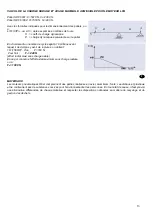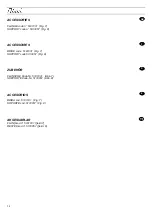
27
GB
USE
To drive the motor in the non reversible version, simply connect the air infeed hose to the compressed air supply and fit
the silencer in position at the exhaust outlet EX (figure 2).
On reversible motors, connect both R and L infeed hoses and then supply compressed air to the one corresponding to
the rotation direction required by the work cycle. Connect the other input to the discharge system. An operator positioned
behind the motor base to connect the L air infeed hose to the compressed air supply will see the shaft rotate in an anti-
clockwise direction. If the R air infeed hose is connected he/she will see the shaft rotate in a clockwise direction.
ADJUSTING THE SPEED
The motor speed can be varied by varying the compressed air line pressure upstream, or by using a choke system,
preferably involving exhaust airflow.
WARNING: adjusting the air flow will modify motor performance.
NOTE: Use the silencer supplied to reduce noise levels or, where possible pipe the exhaust airflow to a separate
chamber.
An example of a connection circuit for the reversing motor is shown in fig. 4:
V1 = valve 2/2, used to stop the air flow.
V2 = 5/2 bistable valve
V2 in position a: right rotation
V2 in position b: left rotation
R1, R2 = flow regulators, used to adjust motor speed
The circuit example shown is purely indicative. The valves can be controlled using either a mechanical, pneumatic or
electric system which can be controlled directly or using a logic circuit remote control or PLC.
F
UTILISATION
Pour actionner les moteurs non reversibles, il suffit de raccorder l'arrivée d'air IN au réseau et de monter le silencieux au
niveau de l'orifice d'échappement EX (figure 2).
Dans le cas des moteurs réversibles, il faut raccorder les arrivées d'air R et L et alimenter l'arrivée correspondant au sens
de rotation requis par le cycle du travail en reliant l'entrée non alimentée à l'évacuation. Quand l'arrivée d'air L est
raccordée au réseau d'alimentation, l'opérateur place derrière le moteur voit l'arbre tourner dans le sens anti-horaire;
quand l'arrivée d'air R est raccordée au réseau d'alimentation, l'opérateur voit l'arbre tourner dans le sens horaire.
REGLAGE DE LA VITESSE
La vitesse de rotation du moteur peut être contrôlée en modifiant la pression de l'alimentation en amont, ou bien en
utilisant un système d'étranglement agissant de préférence sur le flux de sortie.
ATTENTION: en réglant le flux de l'air, on modifie les prestations du moteur.
NOTE: pour réduire l'émission sonore, il faut utiliser le silencieux fourni avec les accessoires et acheminer, si possible, le
flux d'air d'échappement dans un local séparé.
Un exemple de circuit de raccordement du moteur réversible est indiqué sur la fig.4:
V1 = soupape 2/2, utilisable pour interrompre le flux de l'air
V2 = soupape 5/2 bistable
V2 en position a : rotation droite
V2 en position b : rotation gauche
R1, R2 = régulateurs de flux, à utiliser pour le réglage éventuel de la vitesse du moteur.
L'exemple de circuit est purement indicatif ; les soupapes peuvent être à commande mécanique, pneumatique, électrique
et actionnées directement ou par l'intermédiaire d'une télécommande depuis un circuit logique ou un PLC.
D
BETRIEB
Zum Antrieb der Umsteuerbahren Motoren genügt es, die Luftzufuhr IN an das Versorgungsnetz anzuschliessen und den
Schalldämpfer an den Austrittsöffnung EX zu montieren (Abb. 2).
Bei Motoren mit umkehrbarer Drehrichtung müssen dagegen beide Eingänge R und L angeschlossen und jeweils der
gespeist werden, der dem für den Bearbeitungszyklus erforderlichen Drehsinn entspricht, den anderen an die Abluft.
Der hinter dem Motor stehende Bediener muss, bei Anschluss des linken Lufteintritts L an das Druckluftnetz die Welle im
Gegenuhrzeigersinn drehen sehen, während bei Anschluss des rechten Lufteintritts R die Welle im Uhrzeigersinn drehen
muss.
DREHZAHLREGELUNG
Die Drehzahl des Motors kann durch entsprechende Änderung des vorgeschalteten Speisedrucks gesteuert werden. Die
Drehzahlregulierung kann auch über ein Drosselungssystem erzielt werden, das vorzugsweise auf den Ausgangsstrom
wirkt.
ACHTUNG: Bei Änderung der Luftdurchsatz ändert sich die Leistung des Motors.
HINWEIS: Zur Reduzierung der Geräuschentwicklung ist der im Lieferumfang enthaltene Schalldämpfer zu verwenden
und, sofern möglich, der Ausgangsluftstrom in einen getrennten Raum abzuleiten.










































